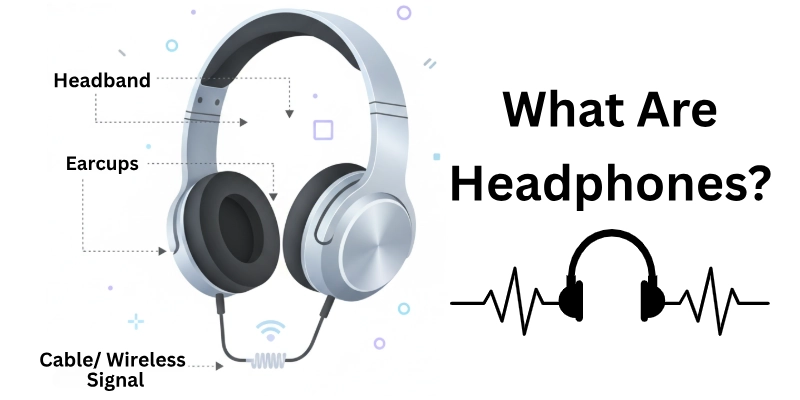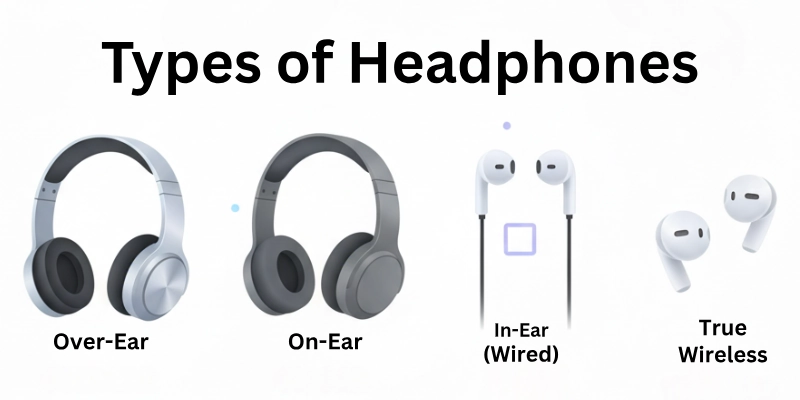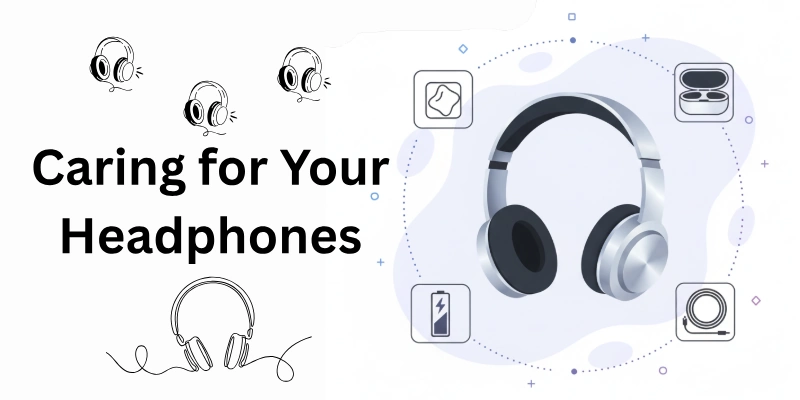Headphones: Definition, History, Working & Much More!
Published: 27 Sep 2025
Did you know that over 70% of people use headphones every day? Headphones are everywhere, helping us enjoy music, podcasts, and calls privately. In this blog post, we will explore ‘What are headphones?’, how they work, the different types available, and tips on choosing the right pair for you.
So, guys, let’s dive into the world of headphones and learn more about this essential gadget!!
What are Headphones?
Headphones are small speakers that you wear over or in your ears. They let you listen to music, podcasts, or phone calls without disturbing others. Headphones can be connected to devices like phones, computers, or music players through a wire or wirelessly using Bluetooth.

They come in different shapes, like over-ear, on-ear, and in-ear designs, each offering unique comfort and sound quality. Headphones are a convenient way to enjoy audio privately and clearly.
History of Headphones
Let’s explore their history, from the first inventions to their evolution and key milestones.
Early Inventions
Ernest Mercadier, a French engineer, invented the first headphones in the late 19th century. In 1910, Nathaniel Baldwin, an American inventor, created the first modern headphones, which the U.S. Navy used.
Evolution
Headphones evolved over the decades, becoming popular for personal music in the 1950s and 1960s. The 1970s brought portable music players, like the Walkman. The 1990s and 2000s saw the rise of wireless headphones, improving convenience and sound quality.
Milestones
Key milestones include John C. Koss’s invention of the first stereo headphones in 1958, the rise of in-ear headphones in the 1980s, Dr. Amar Bose’s invention of noise-canceling headphones in the early 2000s, and the recent popularity of wireless and smart headphones.
Headphones have continuously improved, making them essential to our daily lives.
How Headphones Work
In this section, we will explain how headphones work, their basic components, how they produce sound, and how they cancel noise.
Basic Components
Headphones have several key parts:
- Drivers: These are small speakers inside the headphones that create sound.
- Ear Cups: These cover the ears and help direct sound into them.
- Headband: This connects the two ear cups and keeps the headphones on your head.
- Cables: These connect the headphones to your device, although some headphones are wireless.
Sound Production
Sound in headphones is produced by the drivers. When an electrical signal from your device reaches the drivers, it makes a thin piece of material called a diaphragm move back and forth. This movement creates sound waves that travel through the ear cups and into your ears, allowing you to hear music, voices, or other sounds.
Noise Cancellation
There are two types of noise cancellation in headphones:
- Passive Noise Cancellation: This is done by the design of the ear cups, which block out external sounds physically.
- Active Noise Cancellation: This uses tiny microphones to detect outside noise and then creates sound waves that cancel out those noises, making your listening experience quieter.
Types of Headphones
Headphones come in different types to suit various needs and preferences. Here are the main types of headphones and a brief explanation of each.

- Over-Ear Headphones: Over-ear headphones have large ear cups that cover your entire ears, providing great sound quality and comfort.
- On-Ear Headphones: On-ear headphones have smaller ear cups that sit on top of your ears, offering good sound and portability.
- In-Ear Headphones: In-ear headphones, also known as earbuds, fit inside your ear canal, making them very portable and lightweight.
- Wireless Headphones: Wireless headphones connect to your device via Bluetooth, allowing you to move freely without cables.
- Noise-Canceling Headphones: Noise-canceling headphones use technology to block out external sounds, giving you a quieter listening experience.
Each type of headphone has unique features that make it suitable for different situations and preferences.
Choosing the Right Headphones
Choosing the right headphones can make a big difference in your listening experience. Let’s look at important factors to consider, like purpose, sound quality, comfort, durability, features, and budget.
1. Purpose and Usage
Think about how you will use the headphones. For everyday use, choose something comfortable and easy to carry. For professional use, look for high-quality sound. Sports headphones should be sweat-proof and secure, while gaming headphones need good sound and a microphone.
2. Sound Quality
Sound quality is important for a great listening experience. Look for headphones with clear sound, good bass, and balanced tones. Try different models to see which sound you like best.
3. Comfort and Fit
Comfort is key, especially if you wear headphones for long periods. Choose headphones with soft ear cups and an adjustable headband. In-ear headphones should fit snugly but not too tightly.
4. Durability and Build Quality
Durable headphones last longer. Look for strong materials like metal or high-quality plastic. Check for good construction, like sturdy cables and secure joints.
5. Additional Features
Some headphones have extra features like built-in microphones for calls, controls for music, or water resistance for sports. Decide which features are important for your needs.
6. Budget Considerations
Set a budget and find the best value for your money. Expensive headphones usually have better quality, but there are many good options at lower prices. Compare different models to find the right balance between cost and features.
Popular Headphone Brands
Here are some brand recommendations for your next headphones purchase.
High-End Brands
High-end headphone brands offer top-quality sound and advanced features.
- Bose: Known for excellent sound and noise-canceling technology.
- Sennheiser: Famous for high-fidelity sound and durable build quality.
- Sony: Offers great sound, noise cancellation, and wireless options.
Budget-Friendly Brands
Budget-friendly headphone brands provide good quality at lower prices.
- JBL: Known for strong bass and durable designs at affordable prices.
- Skullcandy: Offers stylish headphones with good sound quality and features for a lower cost.
Niche Brands
Niche brands focus on specific needs like gaming or sports.
- Razer: Specializes in gaming headphones with great sound and built-in microphones.
- Beats by Dre: Popular for sports headphones with strong bass and a secure fit.
These brands offer a variety of options to suit different preferences and budgets.
Caring for Your Headphones
Taking care of your headphones can help them last longer and sound better. Here’s how to keep them in good shape.

1. Cleaning and Maintenance
- Over-Ear and On-Ear Headphones: Wipe ear cups with a damp cloth and mild soap. Clean headbands with a soft brush.
- In-Ear Headphones: Use a soft, dry cloth to clean ear tips. Avoid using liquids near the drivers.
- Wireless Headphones: Clean surfaces gently to avoid damaging electronics.
2. Storage Tips
- Store headphones in a clean, dry place away from dust and moisture.
- Use a headphone case or pouch to protect them from scratches and damage.
3. Troubleshooting Common Issues
- Connectivity Issues: Check Bluetooth settings and ensure headphones are charged.
- Sound Distortion: Clean headphone jacks and ensure cables are securely connected.
- Other Issues: Refer to the user manual or contact customer support for help.
By following these tips, you can enjoy your headphones for a long time and maintain their performance.
Conclusion
In conclusion, we’ve explored headphones thoroughly in this article, from understanding what they are to learning how to care for them properly. Whether you use over-ear, on-ear, or in-ear headphones, maintaining them with regular cleaning and proper storage can extend their lifespan and ensure optimal performance.
If you have any more questions about headphones or need further advice, feel free to ask in the comment section below. Your satisfaction with your headphones is our priority!
FAQs
Here are the most commonly asked questions related to the headphones!
Headphones are small speakers made to be worn on or in the ears. They let you hear sound from devices like phones, computers, or music players. Instead of using big speakers, they give sound directly to you. This makes listening more personal and clear.
Headphones are often called earphones or earbuds. Some people also use the word “cans” for larger over-ear types. The names usually depend on their style and design. All of them serve the same purpose of letting you listen privately.
The main purpose of headphones is to let you enjoy audio without bothering others. They give you a personal listening space wherever you are. You can use them at home, work, or while travelling. They also help you focus on sound without outside noise.
Headphones have small speakers inside, called drivers, that produce sound. They also include ear cups or earbuds that cover or fit in your ears. A headband may hold them in place for over-ear models. Some use wires, while others work with wireless technology.
Headphones have many good sides, like giving private listening and clear sound. They are easy to carry and use anywhere. But wearing them too long can feel uncomfortable. They may also block outside sounds, which can sometimes be unsafe.
Headphones are used to listen to music with better sound. They help in making and receiving calls clearly. Many people use them while gaming for better audio effects. You can also enjoy movies or videos without disturbing others, and they reduce noise in crowded places.
People love headphones because they are simple to use and easy to carry. They make music, games, and videos more enjoyable. Headphones give better sound than most device speakers. They also let you enjoy your own world of sound anytime.

- Be Respectful
- Stay Relevant
- Stay Positive
- True Feedback
- Encourage Discussion
- Avoid Spamming
- No Fake News
- Don't Copy-Paste
- No Personal Attacks

- Be Respectful
- Stay Relevant
- Stay Positive
- True Feedback
- Encourage Discussion
- Avoid Spamming
- No Fake News
- Don't Copy-Paste
- No Personal Attacks





